| A
Wee Bit of History for the Modeler
Near the conclusion of WW2, according to Armor Photogallery #16,
183 M4A2(76) Sherman tanks equipped with the Horizontal Volute Spring
Suspension (HVSS) bogies (a.k.a M4A2E8) were delivered to the Soviet
Union. The new suspension, known as the E8 suspension, offered a
better ride and wider track for better floatation over soft ground.
These M4A2E8 were delivered too late to see action against Germany
but were delivered through Siberia and were used in the Soviet invasion
of Manchuria against Japan. I understand that Emcha is the Soviet
nickname for the Sherman and translates to "M4".
The
M4A2E8 looked very similar to the M4A3E8 (Easy Eight) used by the
US Army but was equipped with twin diesel engines. The diesel engines
necessitated a different engine deck with smaller ventilation grate,
and external mufflers often covered by an exhaust deflector. The
only other users of the M4A2E8 Sherman I understand were the US
Army for training and then by the Canadian Army after WW2. There
could have been other users as well.
The
Kits
Though the Dragon
(DML) kit #7302 offered the best hull and HVSS bogies available
at this time I opted for the lower hull and HVSS bogies from the
Trumpeter
M4A3E8 kit #7225. Why use the 2nd-best Trumpeter kit? Because
the Trumpeter kit was still a decent kit and I just hate to tear
apart a nicer kit like the DML M4A3E8 model just for parts. Of course,
a big question before we can get very far is whether the resin MR
upper hull will mate with the Trumpeter lower hull? For a good in-the-box
preview of the Trumpeter kit please go to http://www.172shermans.com/kitreviews/Trumpeter/M4A3E8prev.htm
The
MR
Model kit MR-7251 is a conversion kit that is designed to be
used with the venerable ESCI (Italeri) M4A1 Sherman kit with VVSS
bogies. At the time it was released the MR conversion kit was one
of few M4A2(76) tank kits available in small scale and is a very,
very good one. The conversion kit comes with about 40 parts: most
in cast resin, 12 are in cast white metal, and with one turned aluminum
gun barrel. Producing an M4A2E8 with HVSS we won’t need the
sprocket and VVSS roadwheels supplied with the kit. For a good in-the-box
preview of the MR conversion kit please go to http://www.172shermans.com/kitreviews/MrModels/M4A2-76prev.htm
Assembling
The Hull

Like
the Dragon kit, Trumpeter supplies us with a nice slide-molded,
styrene plastic one-piece lower hull (the gray colored parts above),
while ESCI and UM make this lower hull from about four separate
parts. The rear M4A2 hull plate from the resin MR kit has been trimmed
and sanded to fit the Trumpeter hull. The two strips representing
the underside of the sponsons have been trimmed back at the front
sides and rear to make it fit into MR’s upper hull. It fit
remarkably well.
Behind
the hull rear are the M4A2 mufflers and exhaust pipes still attached
to its resin pour plug. Two Trumpeter HVSS suspension bogies are
included here in the photo. Trumpeter supplies with their M4A3E8
kit multi-part suspension bogies, and three-part simplified wargaming
suspension bogies.
At
right is the one-piece cast resin M4A2 ‘big-hatch’ hull;
the late Sherman upper hull that would be fitted with the long 76-mm
gun armed T23 turret. On the rear plate is some of the resin pour
plug that still needs to be sanded down smooth. This MR hull is
the finest M4A2 hull I have yet found, the detail and accuracy is
superb. The only things missing from the MR hull are the two grouser
compartment covers: the oval plates on the rear engine deck corners,
behind the lifting rings…small ooops.
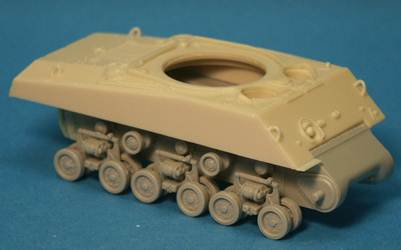
This photo shows a test fit of the MR upper hull to the Trumpeter
lower hull. The small gap above the differential cover bolts will
be fixed when glued in using perhaps a little putty. This is a good
view of the big-hatch hull with the 47 degree glacis slope and the
larger driver’s hatches set diagonal to the glacis. On the
bow is the late style wedge shape (sharp nose) differential cover.

At this point the missing grouser covers have been added from a
UM kit etched brass set. The track tension wrench has been attached
on the engine deck based on scale plans.
When
I wrapped the Trumpeter band track around the Trumpeter sprocket
I found that the track was so flexible that the track dimpled in,
i.e. became concave. I've noticed this with Trumpeter Sherman kits
with the VVSS track as well. To fix this, thick styrene strips were
glued on the inside of the sprocket to support the center of the
track.
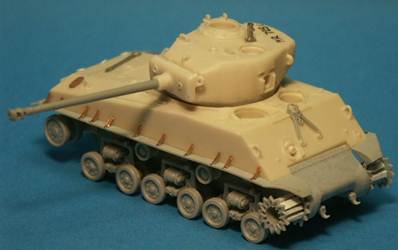
At this point the fender (mudguards) have been cut off the Trumpeter
kit M4A3E8 hull and glued onto the MR hull. The etched-brass braces
from the UM M4A3E8 kit used here are superior to the braces molded
into the Trumpeter mudguards. The 76-mm M1 gun barrel is an extra
from a DML kit. On the side of the turret the pistol port is modeled
open, I like that; MR has the only kit I know that offers the pistol
port open on the T23 turret.
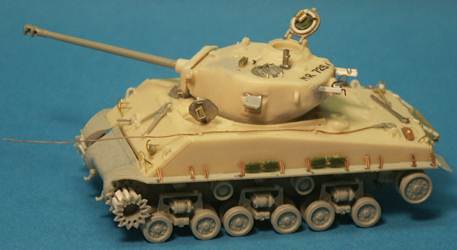
The wire like thing sticking out is a tow cable fabricated from
string from a tea bag and stiffened with white (Elmers) glue and
tow cable ends from a Dragon kit. Since the commander's cupola hatch
is open some detail was added to the hatch underside.
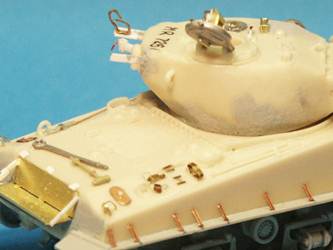 
Good view of the engine deck with the grouser covers and mudguard
braces taken from a UM Sherman kit.
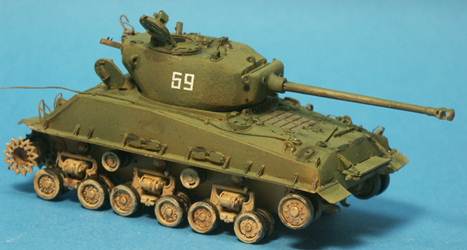
We are missing a few steps in the painting process here; all paints
are Model Master acrylics. A dusty tan color has been airbrushed
onto the lower hull and suspension; tanks operating in a dry European
summer could get quite a coat of dust. The roadwheel face was painted
Poly S Grimy Black color and then the suspension was given a brown
oil wash. The dark splotchy appearance will be blended in later.
The upper hull and turret were first painted in a brown-olive color
then after a day or two drying I gave it a black oil pin wash in
crevices, recesses and around fittings. After a week to allow the
oil wash to dry a light coating of olive green was sprayed on.
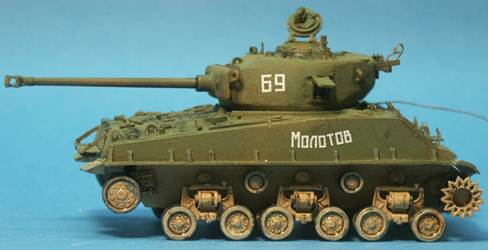
The
markings are a best guess and are rub on from Archer Transfers.
Photos of Soviet Shermans in Manchuria, 1945 are rare.
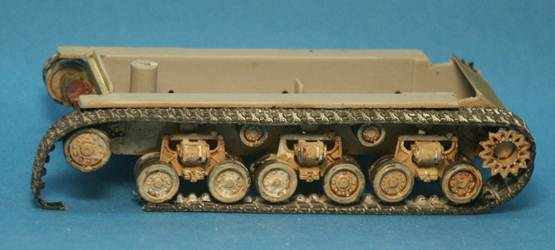
DISASTER
STRIKES! What I typically do is attach the two ends of the band
track, glue the track into the sprocket teeth and then stretch it
back over the roadwheels and idler. Alas, when I did this I found
the track to be several links short, it stretched, but then ripped
apart, DAMN! Strange track this is; it is also oddly resistant to
super glue (cyanoacrylate glue); the glue would eventually hold
but the track could be gently pulled away from the wheels breaking
the super glue’s adhesion. It was important that I use this
style of Sherman type T-66 HVSS track as it is the type I think
most likely to be delivered to the Soviets in 1945.

DISASTER
PART 2. For the second run of track I thought, hoped, I could gently
stretch the track till it was long enough to safely attach to the
suspension. We can see the results sitting on the table: it ripped
too! All was not lost though, gluing the track to the wheels I found
some extra links of about the same width and thickness that I could
use on the bottom run and not be too visible.
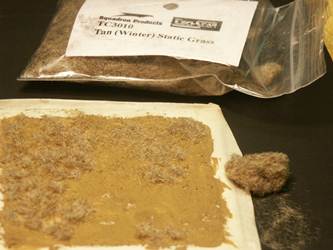
For the display base I found a sample piece of Formica counter top
material that I painted with water based paint and I then glued
on Static Grass to represent late summer grassland of Manchuria
in 1945.
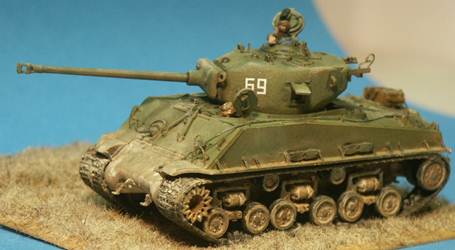
Here we jump ahead to the completed M4A2E8 mounted on its display
base. Weathering is done with a fine mist of thinned acrylic paint
and pastel and pigment powders. Highlighting is with Tamiya Weathering
Master which is essentially woman's cake makeup and applied with
a foam applicator.
There is a small gap between the fifth roadwheel back and the track
indicating the super glue did not hold and the track separated;
odd track material this is.
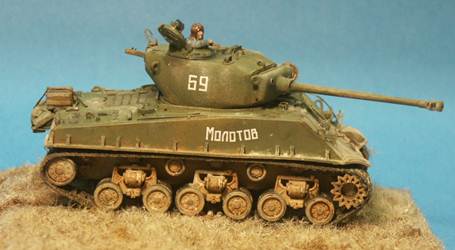
Space has been left on the base on the Sherman's right for an eventual
Japanese Type 97 tank to portray a diorama for the Soviet conquest
of Manchuria in August 1945.

The tank's stern showing some stowage included in the MR kit and
a wood box. The tow cable is facsimilated from teabag string and
end shackles come from a Dragon M4 kit.
References
- Armored
Thunderbolt, The U.S. Army Sherman in World War II, by Steven
Zaloga, Stackpole Books (2008), ISBN: 978 0 8117 0424 3. I have
the highest recommendations for this book; for a modeling and
history fan this book was an absolute pleasure to read, twice.
- Modeling
the US Army M4(76mm) Sherman Medium Tank, by Steven J Zaloga,
Osprey Modeling, Osprey Publishing (2006).
- M4A2
Sherman Part 2: 76 mm Gun Tank, Armor Photogallery #16, by Wojciech
J. Gawrych, Model Centrum Progres (2007). ISBN 978 83 60672 01
3
- Battleline
2, Comrade Emcha, Red Army Shermans of WW2, by Claude Gillono
with Leife Hulbert, The Oliver Publishing Group (2011). ISBN 978
0 9806593 7 5
- http://the.shadock.free.fr/sherman_minutia/sherman_types/m4a2.html
- http://the.shadock.free.fr/sherman_minutia/engine_deck/engine_decks.html
- http://the.shadock.free.fr/sherman_minutia/turret_types/76mm_turrets.html
|



